This post will show you precisely how to repair a hole in the wall. You’ll be done in no time! Filling a hole in the wall can seem to be a huge task, but it’s really very easy. With minimal tools and the tutorial below, you should be on your way to being an expert hole-filler.
Duration of job: the work itself will probably take you an hour in total, but because various parts of the job requires material drying, the job will take about 2 days to complete.
Difficulty: 2 out of 10
If you happen to be in need of tools to help you get the drilling in question done, the Anglia Tool Centre UK have an interesting and quite extensive list of tools for you to browse. They provide a wide range of equipment for trade and public use.
How to repair a hole in the wall
The holes in the picture below were caused by a shelf falling off. As you can probably work out, the six holes were left by a pair of shelf brackets. The wall plugs for the job were incorrect, so obviously, the shelf couldn’t hold up the weight it was given (you learn from your mistakes, right?). You can learn how to drill holes from this article. In the meantime, I’m going to show you how to repair a hole in the wall. So here’s what the wall looked like…
You can easily repair a hole in the wall with these simple steps
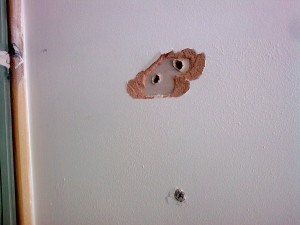
If the wall plugs are still in the holes, leave them there. They’re useful for keeping the dust from the brick or plaster (the stuff the wall is made of) from becoming loose and falling out. If the hole does not have a wall-plug in it, you can place one in if you can. If not, don’t worry, just follow these next steps in the directions.
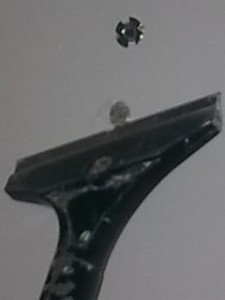
Cut off the rim of the wall plug, leaving the rest of it (the long part) inside the hole to be filled.
Notice in this case, we replaced the plastic wall plugs with metal ones which were suitable for the type of wall we were dealing with. This is a hollow wall (or a plaster board wall). You can use a wall-paper stripper or sharp knife to cut plastic wall-plug rims off.
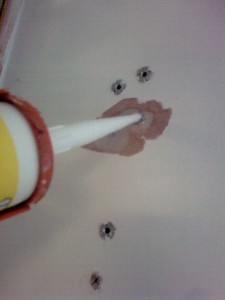
After you’ve cut off the rim of the wall-plug, use any type of suitable filler to fill the hole. Flexible filler is ideal because it moves with any friction or contraction weather (or other conditions) will influence upon the wall.
Press the filler into the hole with your fingers or a filler tool (fingers are fine for this part of the job). Make sure the filler comes to the edge of the hole. Allow to dry according to the manufacturer’s specifications.
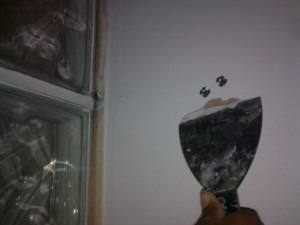
Once your flexible filler is dry, use a filler or scraper tool like the one above to scrape away any loose paint, plaster or material from the area. If you don’t take this precaution all your work will fall off with the dusty, loose particles in a few weeks.
Use the same tool to then apply sandable filler in and around the hole. The reason it has to be sandable is because you need to fill it a bit proud of the hole (It shrinks while it dries). This means you should apply it so that the area filled is higher than the rest of the wall.
Don’t worry about imperfections at this stage of repairing your hole in the wall. They will all be sanded off when the filler is dry. Press the filler firmly into the hole and make sure it (and around it) is covered completely. Allow to dry. This usually takes about 8 to 12 hours. If it’s not dry, it won’t work.
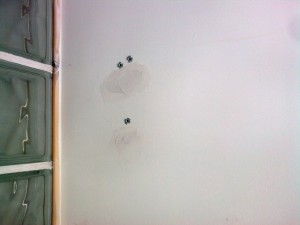
New wall-plugs have been placed into freshly-drilled holes. The old holes (and around them) have been filled. The filler is dry. Now it’s time to do the sanding. Choose a fine to medium sandpaper to do this job. Coarse sandpaper is not suitable to repair a hole in the wall.
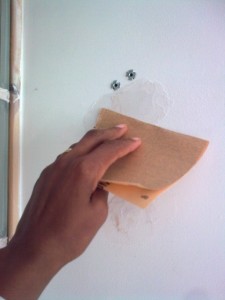
When repairing holes, the trick with sanding filler properly is not only about how it looks, but how it feels. If you have colour paint on the wall, the filled spot will always look different to the rest of the surface. What matters is that when you rub your hand (rub your hand over the spot, because your palms are more sensitive to touch than your fingers are). The sanded spot should feel flat against the wall. If it feels slightly lumpy or a bit higher than the surface, it means you should sand it a bit more.
The picture immediately above was taken after 1 coat of primer and 1 coat of paint. It needs a couple more coats of paint to look perfect. (See the picture below for the finished product).
Not every DIYer will tell you this, but I like to prime filled areas before I paint them. Paint can easily peel off surfaces which are not prepared to properly absorb the paint. Newly sanded, or newly plastered areas should always be primed before they’re painted. Your lovely paint on your new wall will not look so lovely when it starts peeling off in six months’ time. It’s best to take the time to do your preparations right – the first time!
Primer need not be expensive. I buy cheap, white, matt emulsion paint for walls/ceilings to use as primer. I make a solution of half paint with half water and use this for priming. If the paint is really thick, mix about 3 or 4 part water with 1 part paint. It has to be white, matt emulsion.
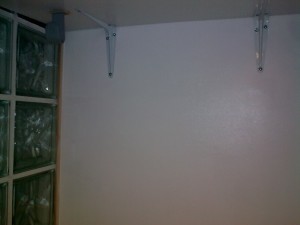
You probably need to use about 2 coats of paint after the primer is dry. Do you see where the holes were? No sign of them! Make sure each coat of paint is dry before applying another. This is important for the finished look. If using white paint, you may need to apply about 3 coats. Note, each coat takes about 2 hours to dry.
No sign of holes! The shelf is up again and the unsightly holes are gone.
Now you know how to repair a hole in the wall yourself. You can easily do this yourself. No calling out the professionals. No calling 0845 numbers looking for workmen who can fit you into their schedule. Use this tutorial and you’ll be proud of what you can do.
If you like ‘How To Repair A Hole In The Wall’ why not check out the other diy tutorials on this site. Find more DIY tutorials here.

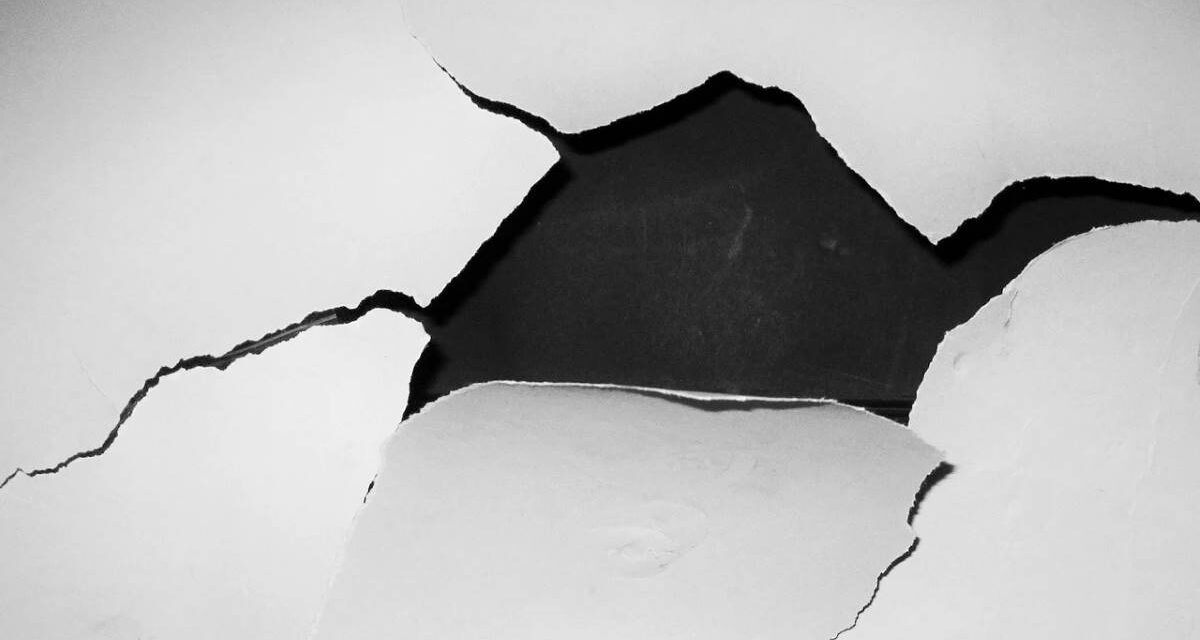
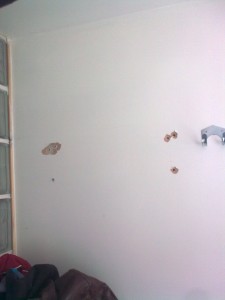
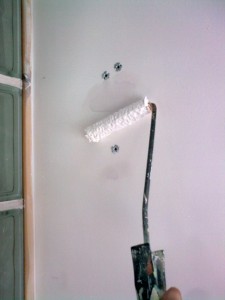
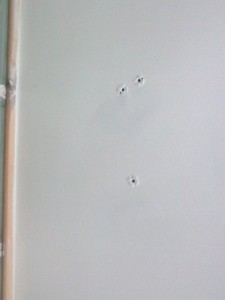


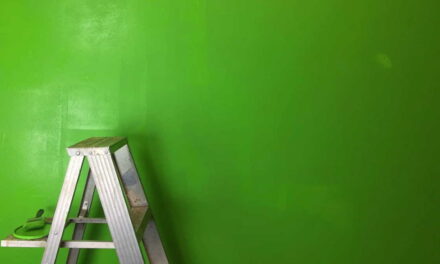
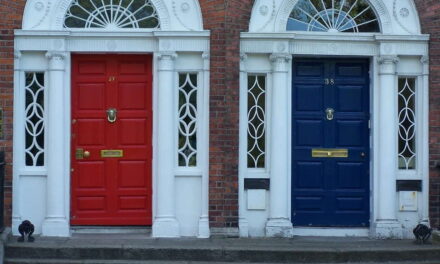
Anne, I am very excited that you post all these things that we can do ourselves. As women, sometimes we don’t know how to do the handy stuff. For me, being a single mom, this stuff really helps.
this is fantastic! will fix mine starting now.. 🙂
Thanks for your tips, My room’s wall have so many holes of nail. 🙂
Hi Anne,
I really thank you so much for detailing this post.After reading this post i have managed to repair the hole in my house.I am feeling so happy that i managed to do this work on my own.I feel the satisfaction in my heart when i am able to do something on my own and hence i really value your post.
I have clearly read the entire post and I am glad you are helping people save so much of money on these small things that we can do ourselves. However, I am confused about the items to buy for filling the holes because I might not have anything at home from the material required. Hope it is not much expensive.
Hi David,
The fillers are usually very cheap from DIY shops and supermarkets. The tools are also easily available. You may not even have to buy them. Just borrow them from a friend or neighbour. They were some of the first ones I bought.
Yes actually it is very easy to fill small holes in the walls of the house. It hardly takes up a few minutes. We usually mix cement and water to make a thick paste and fill them in the holes. Once it is dry, we paint the area of that wall with the same colour of the wall. This saves a lot of money.
Tom, I would advise against using cement. Your wall is not made of cement, so filling a hole with cement (unless you have a terribly huge gaping wound) is not recommended.
Even if you do fill a huge gap with cement, you usually have to put filler or something similar on top of that. Cement can’t be sanded down and it doesn’t look good when painted.
Your wall will look terribly uneven and rough with cement fillers. I hope this makes sense.
Well, with the help of your post, this task of filling the holes in the house or workplace look easy. I am surely going to try it myself as soon as I get a day off because there are small holes in the wall of my bedroom. This way I can save a lot of money on professional help. Thanks.
HI Lina, if you follow these pointers, you can’t go wrong. Decorators charge quite a lot for this type of work, and with a little know-how you can do it yourself.
Thanks for sharing this post. I have a close and hilarious memory from my childhood of this situation. When I was young, I used to fill such small holes in the walls of my house with chewing gums. I thought it would help, but I remember getting badly beaten up by my mom after that. I still laught on it when I recollect.
Ahh… Jack. Not a pleasant memory. I suppose chewing gum would help – but only for a very short time… 🙂
Great idea, I have many to hide..:P
🙂 Let me know if you need any more help, Anthony.